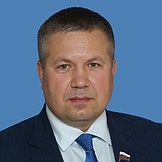Regional flags and emblems


PROFILE
Established 15 July 1929
Capital Naryan-Mar
The Nenets Autonomous Area is part of the Northwestern Federal District
Area 176,800 sq km
Population 41 800 (2025)
Ethnic groups
(2020 National Census, %)
Russian – 69,57
Nenets – 17,95
Komi – 6,50
Ukrainian – 1,32
Other – 4,66
Administrative divisions (2024)
Municipal districts – 1
City districts– 1
Rural towns – 1
Rural districts – 18
Geography and climate
The Nenets Autonomous Area is in the northeast of the European Russian Federation, mostly within the Polar Circle. On the mainland, it measures, at the longest, 300 km north to south and 1000 km west to east. It is washed by the White, Barents and Kara seas of the Arctic Ocean. The Area also includes Kolguyev and Vaigach islands and the Kanin and Yugorsky peninsulas.
It borders on the Komi Republic, Arkhangelsk Region, and the Yamal-Nenets Autonomous Area.
The Area is predominantly flat, with 90% of it lying within the range of 100 m above the sea level, as a result of which it abounds in small lakes and marshes. Standing out are Timansky Range and Pay-Khoy Range. The main rivers are Pechora and its tributaries. The Area is rich in oil and gas.
The climate is distinctly continental, Arctic and sub-Arctic. January temperatures average –7,8°C, while July temperatures average +13,2°C.
The region is home to the Nenets Nature Reserve, seven state nature reserves, three natural sanctuaries and a nature park.
Government
The legislative branch is represented by the Assembly of Deputies of the Nenets Autonomous Area. The Assembly is the permanent, representative and only body of legislative authority in the Nenets Autonomous Area.
The Assembly of Deputies includes 19 deputies and is elected for 5 years: 8 deputies are elected in single-member constituencies; 11 deputies are elected in the single electoral district in proportion to the number of votes cast for lists of candidates nominated by electoral associations.
The current composition of the Assembly of Deputies of the Nenets Autonomous Area was elected on September 2023. Its term of office will expire in September 2028.
The executive branch comprises the Administration of the Nenets Autonomous Area, which is the supreme permanent body of executive authority of the Nenets Autonomous Area.
The Governor is the highest-ranking official who forms and heads the Administration of the Nenets Autonomous Area and is elected for five years by the deputies of the Assembly of Deputies of the Nenets Autonomous Area. The term of office of the Acting Governor – until the person elected Governor of the Nenets Autonomous Area takes office.
Economy and natural resources
Industrial output accounts for over 80% of the regional GDP. The Timan-Pechora Fuel and Energy Complex is being established in the Area based on its oil, gas and coal deposits. There are 12 industrially exploited deposits of hydrocarbons. During the last few years, the Area has grown in importance as an energy-rich region, what with the discovery of considerable hydrocarbon reserves, including 81 oil and gas fields.
The southeastern Barents Sea and the western coast of the Kara Sea are important fishery areas. Unique whitefish and salmon populations have been preserved in the Pechora basin. The industrial fish resources include herring, navaga, codfish, lancet fish, halibut, perch, etc.
Reindeer breeding is an important traditional industry kept going by 12 collective farms, about 50 private farms, and an experimental production farm. The Area has a fish-processing factory, a meat-packing plant, a greenhouse facility, and a woodworking factory.
The biggest industrial facility is the Naryan-Mar Power Station that accounts for 80% of electric power produced in the Area and caters to the city of Naryan-Mar and the town of Iskately. All other populated localities are supplied with electricity by local diesel power plants. There are practically no overland transport communications, with the bulk of regular freight and passenger carriage performed by aircraft. The Area also has two seaports.
Culture and tourism
The Nenets Autonomous Area is of much interest to those who engage in extreme, geological, ethnographic and environmental tourism.
The Area includes the Nenetsky State Reserve, which measures almost 314 ha, of which 182 ha are in the sea. The reserve occupies the northeast of Malozemelnaya tundra, the Pechora delta, and all the islands in the Pechora Bay. It boasts both unique endemic plants and rare bird and animal species, Rare whale species call out in the bays.
Rare fish species – navaga and salmon – come to spawn in the Pechora delta, lakes abound in salmon, omul, and grayling.
Paleolithic camps (8 millennium BC) and Bronze-age settlements have been discovered in the Area. Two hundred monuments of the ancient Nenets culture – sanctuaries, burial grounds, camps, idols and altars – have been found on Vaigach Island, the sacred island of the Nenets.
In 1991, the Pustozersky Historical and Nature Museum was opened in Naryan-Mar, which is also a research facility for archeologists, historians and environmentalists. The museum hosts exhibitions and lectures and organizes archeological expeditions.
There are 320 amateur folklore companies that perpetuate the ancient cultural traditions of the small peoples of the North by regularly participating in national and international festivals and celebrations.
Visitors to local festivals and exhibitions are offered unique articles made from leather, fur, wood, bone and antler in keeping with ancient traditions. They can also watch the manufacturing process itself.


